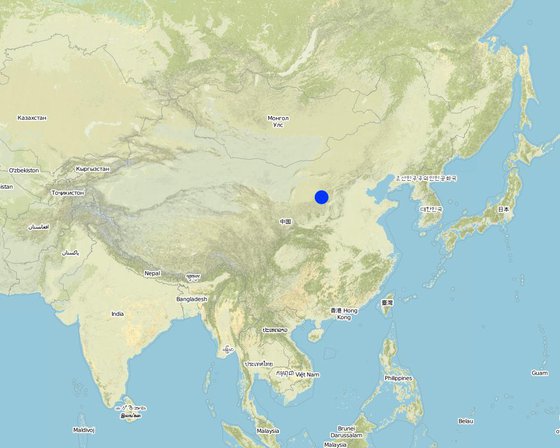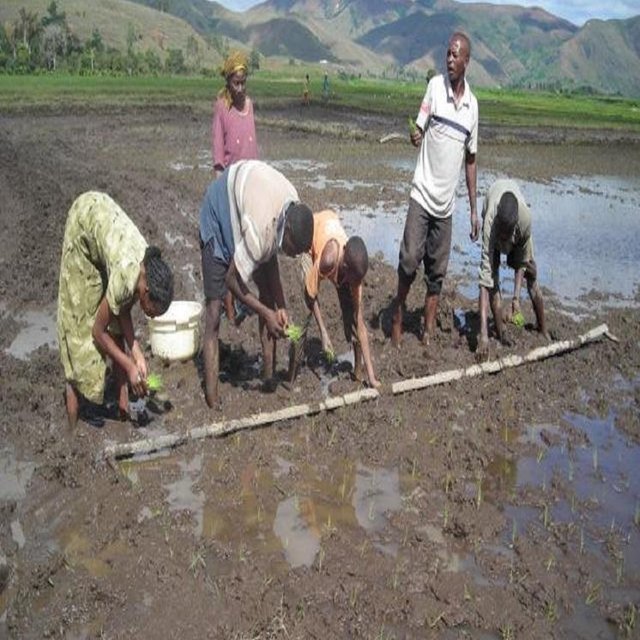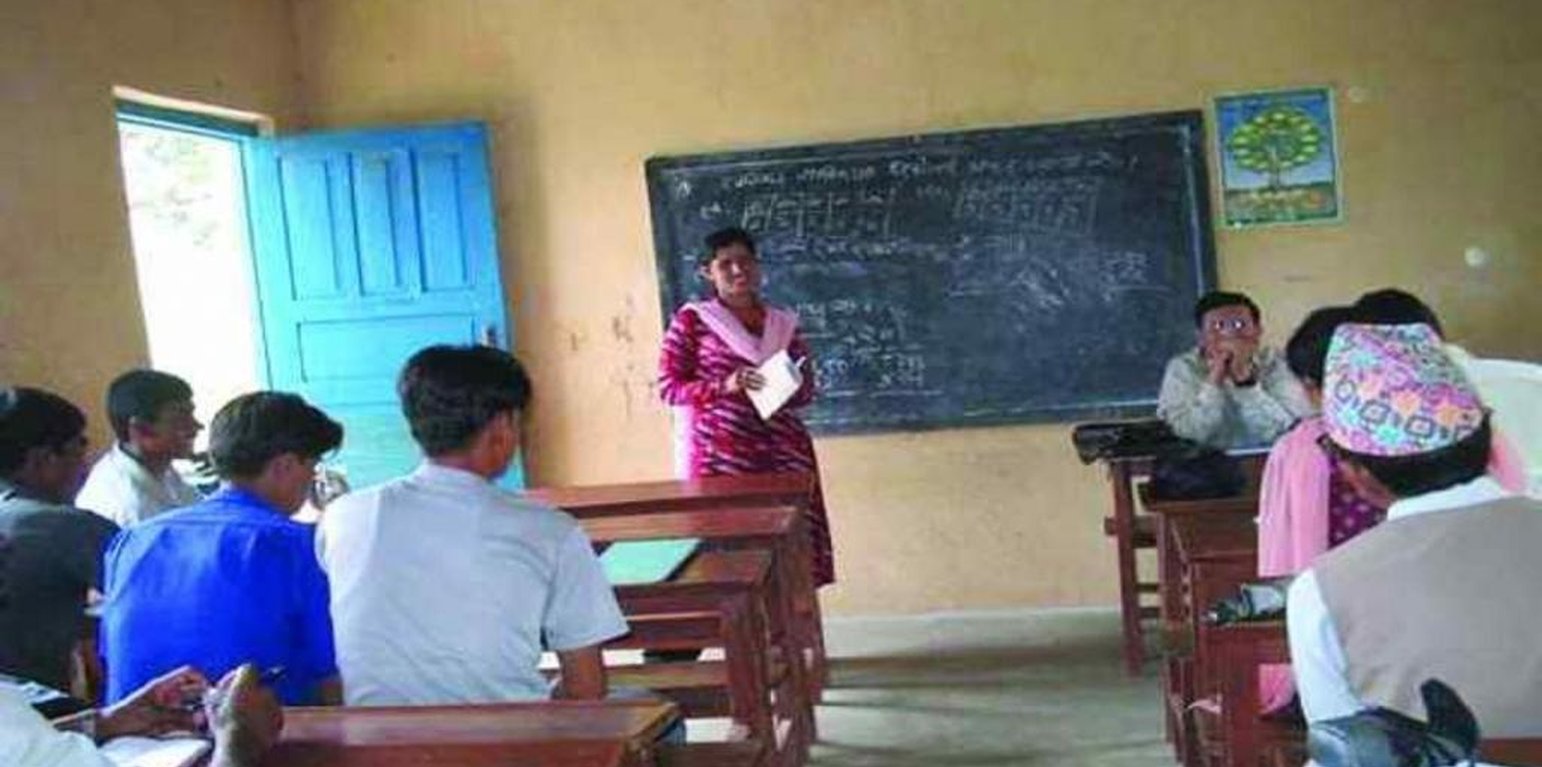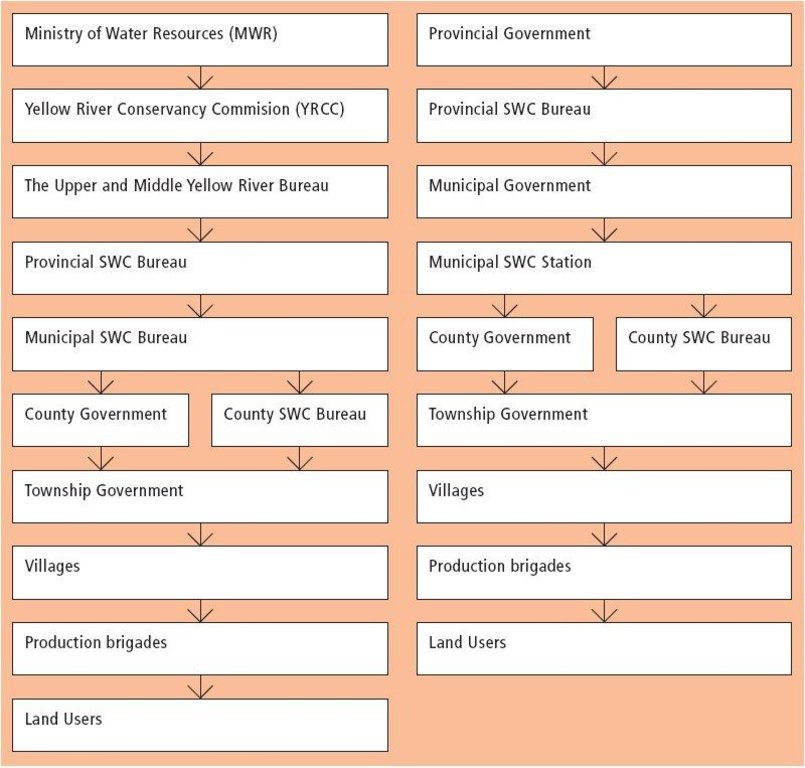Terrace approach
(ຈີນ)
ຄຳອະທິບາຍ
Highly organised campaign to assist land users in creating terraces: support and planning from national down to local level.
Before 1964, the slopes on China's Loess Plateau were cultivated up and down by machinery. Consequently soil and water were lost at high rates, and fertility and yields declined. Accessibility to cultivated land became more and more difficult due to dissection by gullies. The first terraces were established by self-mobilisation of the local land users. However there was no standard design. Furthermore, as the individual plots were very small and scattered all over the village land, terracing needed better coordination. Between 1964 and 1978, the local government at the county level took the initiative of organising farmers and planning terrace implementation according to specific technical design on a larger scale. At that time the land was still communally managed by production brigades. Through mass mobilisation campaigns people from several villages were organised to collectively terrace the land - village by village - covering around 2,000 hectares each year. Labour was unpaid.The Yellow River Conservancy Commission (YRCC) came into being in 1948 - and the Upper and Middle Yellow River Bureau in 1977. This gave greater impetus to the implementation of SWC in the Loess Plateau. After 1978, land use rights were allocated to individuals (though official ownership was still vested in the state). SWC specialists and county level SWC bureaus started to work with groups of farmers who had land use rights within a given area. Survey and design were carried out. The farmers organised themselves, consolidated the parcels of land, and then after the conservation work was done they redistributed the terraced fields.
In the 1980s the government started to financially support land users involved in SWC projects. Subsidies ranged from (approx.) US$* 20/ha in projects at county level, to US$* 55/ha for national projects (eg through the Yellow River Commission), and up to US$* 935/ha when World Bank projects were involved - as in the recent past. Implements were provided by the farmers themselves. Then, in 1988 a nationwide project in SWC - which originally was proposed at county level - was approved by the national government. Furthermore, in 1991 a national law on SWC came into force. Protection of the Yellow River and associated dams became a priority at regional and national levels. In total, within Zhuanglang County, 60 SWC specialists/extensionists cover an area of 1,550 km2, and most of the terraces were built with low levels of subsidies. Annual plans about implementation of new SWC measures were made during summer. Small areas were planned at village or township level, whereas bigger areas (> 7 hectares) were designed at county level. Implementation then took place during winter. Terracing was implemented first where access was easiest and closest to settlements, and only later, further away. * exchange rate: 1 US$ = 8 Chinese Yuan (May 2006).
ສະຖານທີ່

ສະຖານທີ່: Gansu Province, Loess Plateau Region, ຈີນ
ການຄັດເລືອກພື້ນທີ່ ທີ່ອີງໃສ່ຂໍ້ມູນທາງພູມີສາດ
ວັນທີເລີ່ມຕົ້ນ: 1964
ປີຂອງການສິ້ນສຸດ: n.a.
ປະເພດຂອງແນວທາງ
-
ພື້ນເມືອງ / ທ້ອງຖີ່ນ
-
ການລິເລີ່ມ ພາຍໃນປະເທດ ທີ່ຜ່ານມາ / ນະວັດຕະກໍາ
-
ພາຍໃຕ້ໂຄງການ / ແຜນງານ

Construction of terrace risers - following instructions given by a specialist.
ເປົ້າໝາຍຂອງແນວທາງ ແລະ ການປົກປັກຮັກສາສິ່ງແວດລ້ອມ
ເປົ້າໝາຍ / ຈຸດປະສົງຫຼັກໃນການຈັດຕັ້ງປະຕິບັດແນວທາງ
Aims of the approach are: - water conservation (this is a semi-arid area), - soil conservation: reduce soil loss on the sloping and erosion-prone land of loess plateau, - enhancing soil fertility, and consequently production, - improve people's living conditions, These primary objectives were to be achieved by building level bench terraces on a large scale through a structured and organised campaign. Finally at the national level, a fourth aim was added: the protection of the Yellow river (avoiding floods and reducing the sediment load)
The SLM Approach addressed the following problems: - lack of organisation, capital and technical knowledge in farmer communities to counter the underlying problems of water loss, soil loss, fertility decline and downstream effects on the Yellow River (floods and sediment) at catchment level, - absence or poor maintenance of erosion control measures
ເງື່ອນໄຂທີ່ສະໜັບສະໜູນໃຫ້ການຈັດຕັ້ງປະຕິບັດເຕັກໂນໂລຢີ ບົນພື້ນຖານແນວທາງ
ເງື່ອນໄຂທີ່ເຊື່ອງຊ້ອນໃຫ້ການຈັດຕັ້ງປະຕິບັດເຕັກໂນໂລຢີ ບົນພື້ນຖານແນວທາງ
-
ມີຄວາມສາມາດ / ເຂັ້າເຖິງຊັບພະຍາກອນດ້ານການເງິນ ແລະ ການບໍລິການ: Initially farmers were not paid and as they had no immediate benefit from, or security over, the use of the land. The investment in construction was a heavy burden on poor farmers.
Treatment through the SLM Approach: After 1988, labour inputs by farmers started to be partly covered by subsidies provided by local and national government
-
ກ່ຽວກັບກົດໝາຍ (ສິດນໍາໃຊ້ດິນ, ສິດນໍາໃຊ້ນໍ້າ): Land users leased the land from the state and land users??? rights were insecure in the long term. Investments in SWC were not encouraged.
Treatment through the SLM Approach: National government persuaded land users to implement terraces by 'selling' the benefits (increased yield and easier workability of the land). After 1978, individual user rights motivated farmers to invest in SWC.
The existing land ownership, land use rights / water rights hindered a little the approach implementation Ownership of land and its resources belongs to state and communities: land users only lease the land for a period of time. Due to uncertainty over future user rights and possible reallocation in response to changes in population and household needs, additional investments into measures may be hindered. 1978 a first major change took place by allocating some individual land use rights.
-
ຄວາມຮູ້ກ່ຽວກັບການຄຸ້ມຄອງ ທີ່ດິນແບບຍືນຍົງ, ການເຂົ້າເຖິງການສະໜັບສະໜູນ ທາງດ້ານວິຊາການ: Poor knowledge of how to reduce water loss, soil loss and fertility loss. Technical solutions were needed at the catchment level, involving the whole population.
Treatment through the SLM Approach: Enhanced guidance by SWC specialists.
ການມີສ່ວນຮ່ວມ ແລະ ບົດບາດຂອງພາກສ່ວນທີ່ກ່ຽວຂ້ອງທີ່ມີສ່ວນຮ່ວມ
ພາລະບົດບາດຂອງພາກສ່ວນທີ່ກ່ຽວຂ້ອງ ທີ່ມີສ່ວນຮ່ວມໃນການຈັດຕັ້ງປະຕິບັດແນວທາງ
| ແມ່ນໃຜ / ພາກສ່ວນໃດ ທີ່ເປັນເຈົ້າການ ໃນການຈັດຕັ້ງປະຕິບັດ ວິທີການ? |
ລະບຸ ພາກສ່ວນທີ່ກ່ຽວຂ້ອງ |
ພັນລະນາ ບົດບາດ ໜ້າທີ່ ຂອງພາກສ່ວນທີ່ກ່ຽວຂ້ອງ |
| ຜູ້ນໍາໃຊ້ດິນໃນທ້ອງຖິ່ນ / ຊຸມຊົນທ້ອງຖິ່ນ |
|
|
| ພະນັກງານຂັ້ນສູນກາງ (ຜູ້ວາງແຜນ, ຜູ້ສ້າງນະໂຍບາຍ) |
|
|
ການລວບລວມເອົາຜູ້ນໍາໃຊ້ທີ່ດິນໃນທ້ອງຖິ່ນ/ຊຸມຊົນທ້ອງຖິ່ນ ໃນການຈັດຕັ້ງປະຕິບັດແນວທາງ ແຕ່ລະໄລຍະ
ບໍ່ມີ
ການບໍ່ປະຕິບັດ
ການຊ່ວຍເຫຼືອຈາກພາຍນອກ
ການຮ່ວມມື
ການນໍາໃໍຊ້ເອງ
ການເລີ່ມຕົ້ນ / ແຮງຈູງໃຈ
Land users started implementing terraces but SWC specialists at the country level assisted in designing standards for terrace construction and township governments and production brigades organised whole villages and watersheds
ການວາງແຜນ
Being consulted in the planning phase. Experienced peasants may be involved in introducing the local situation.
ການປະຕິບັດ
Major organisation done through the SWC bureau specialists with the village organisation including land users. Land users were actively involved in implementation.
ຕິດຕາມກວດກາ / ການປະເມີນຜົນ
reporting; No participation of land users
Research
on-station; No participation of land users
ແຜ່ນວາດສະແດງ
Terrace construction supported by projects from MWR, YRCC and international organisations (left) and terrace construction supported by provincial funds (right).
ການຕັດສິນໃຈໃນການເລືອກເຕັກໂນໂລຢີ ການຄຸ້ມຄອງທີ່ດິນແບບຍືນຍົງ
ການຕັດສິນໃຈໂດຍ
-
ຜູ້ນໍາໃຊ້ດິນຜູ້ດຽວ (ການລິເລີ່ມດ້ວຍຕົນເອງ)
-
ຜູ້ນໍາໃຊ້ທີ່ດິນຫຼັກ, ການສະໜັບສະໜູນ ໂດຍຜູ້ຊ່ຽວຊານ ການນໍາໃຊ້ທີ່ດິນແບບຍືນຍົງ
-
ພາກສ່ວນກ່ຽວຂ້ອງທັງໝົດ, ເປັນສ່ວນໜຶ່ງ ຂອງວິທີທາງແບບມີສ່ວນຮ່ວມ
-
ຜູ້ຊ່ຽວຊານ ຫຼັກດ້ານການຄຸ້ມຄອງ ທີ່ດິນແບບຍືນຍົງ, ມີການຕິດຕາມປຶກສາຫາລືກັບຜູ້ນໍາໃຊ້ທີ່ດິນ
-
ຊຽ່ວຊານ ສະເພາະດ້ານການຄຸ້ມຄອງ ດິນແບບຍືນຍົງຜູ້ດຽວ
-
ນັກການເມືອງ / ຜູ້ນໍາ
ການຕັດສິນໃຈບົນພື້ນຖານ
-
ປະເມີນເອກກະສານ ຄວາມຮູ້ກ່ຽວກັບ ການຄຸ້ມຄອງ ທີ່ດິນແບບຍືນຍົງ (ຫຼັກຖານທີ່ຊ່ວຍໃນການຕັດສິນໃຈ)
-
ຜົນທີ່ໄດ້ຮັບ ຈາກການຄົ້ນຄວ້າ
-
ປະສົບການສ່ວນບຸກຄົນ ແລະ ຄວາມຄິດເຫັນ (ທີ່ບໍ່ເປັນເອກກະສານ)
ການສະໜັບສະໜູນເຕັກໂນໂລຢີ, ການສ້າງຄວາມອາດສາມາດ ແລະ ການຄຸ້ມຄອງຄວາມຮູ້
ກິດຈະກຳ ດັ່ງລຸ່ມນີ້ ແມ່ນເປັນພາກໜຶ່ງຂອງແນວທາງ
-
ການສ້າງຄວາມສາມາດ / ການຝຶກອົບຮົມ
-
ການບໍລິການໃຫ້ຄໍາປຶກສາ
-
ສະຖາບັນການສ້າງຄວາມເຂັ້ມແຂງ (ການພັດທະນາອົງການຈັດຕັ້ງ)
-
ຕິດຕາມກວດກາ ແລະ ປະເມີນຜົນ
-
ການຄົ້ນຄວ້າ
ການສ້າງຄວາມອາດສາມາດ / ຝຶກອົບຮົມ
ໄດ້ສະໜັບສະໜູນຝຶກອົບຮົມໃຫ້ແກ່ພາກສ່ວນກ່ຽວຂ້ອງດັ່ງລຸ່ມນີ້
-
ຜູ້ນໍາໃຊ້ດິນ
-
ພະນັກງານພາກສະໜາມ / ທີ່ປຶກສາ
ຮູບແບບການຝຶກອົບຮົມ
-
ການເຮັດຕົວຈິງ
-
ຕົວຕໍ່ຕົວ
-
ເນື້ອທີ່ສວນທົດລອງ
-
ກອງປະຊຸມ
-
ຫຼັກສູດ
ກວມເອົາຫົວຂໍ້
Until 1978 the 'pyramid system' was used: the county level trained the township level, which trained the village level, which in turn trained the production brigades/farmers, who then trained other production brigades and farmers.
ການບໍລິການທາງດ້ານການໃຫ້ຄໍາປຶກສາ
ໄດ້ຮັບການບໍລິການທາງດ້ານການໃຫ້ຄໍາປຶກສາ
-
ໃນພື້ນທີ່ຂອງຜູ້ນໍາໃຊ້ດິນ
-
ສູນຄົ້ນຄວ້າ
Key elements: Pyramid system is also used for extension. At each government level (county, district and provincial levels) there is a SWC division in charge of SWC activities includ. extension (farm visits)
ຄວາມເຂັ້ມແຂງຂອງສະຖາບັນ
ສະຖາບັນ ໄດ້ຮັບການສ້າງຄວາມເຂັ້ມແຂງ
-
ບໍ່ມີ
-
ມີ, ໜ້ອຍໜຶ່ງ
-
ມີ, ພໍສົມຄວນ
-
ມີ, ຫຼາຍ
ໃນລະດັບດັ່ງລຸ່ມນີ້
-
ທ້ອງຖິ່ນ
-
ລະດັບພາກພື້ນ
-
ແຫ່ງຊາດ
ອະທິບາຍສະຖາບັນ, ພາລະບົດບາດແລະຄວາມຮັບຜິດຊອບ, ສະມາຊິກ, ແລະອື່ນໆ.
ຮູບແບບການສະໜັບສະໜູນ
-
ທາງດ້ານການເງິນ
-
ການສ້າງຄວາມອາດສາມາດ / ການຝຶກອົບຮົມ
-
ອຸປະກອນ
ລາຍລະອຽດເພີ່ມເຕີມ
ການຕິດຕາມ ແລະ ປະເມີນຜົນ
bio-physical aspects were regular monitored through measurements; indicators: runoff loss, sediment load, soil moisture
technical aspects were regular monitored through measurements; indicators: structure of terraced areas, slope of risers, levelness of terrace surface
socio-cultural aspects were ad hoc monitored through observations; indicators: land users' perceptions of terraces
economic / production aspects were regular monitored through measurements; indicators: yield, income of land users
area treated aspects were regular monitored through measurements; indicators: terraced area
land users involved aspects were ad hoc monitored through measurements; indicators: number of farmers directly involved in terracing and farmers benefited directly
management of Approach aspects were ad hoc monitored through observations; indicators: number of small watersheds terraced
There were changes in the Approach as a result of monitoring and evaluation: The approach changed fundamentally from self-mobilisation to organised mass movements guided by the government.
ການຄົ້ນຄວ້າ
ການວິໄຈໄດ້ຮັບການຮັກສາຫົວຂໍ້ຕໍ່ໄປນີ້
-
ສັງຄົມ
-
ເສດຖະສາດ / ການຕະຫຼາດ
-
ລະບົບນິເວດ
-
ເຕັກໂນໂລຢີ
carried out at the provincial and national levels, mostly by technical staff. Land users have not been involved. Terrace building is based on scientific design, according to local conditions.
Research was carried out on station
ການສະໜັບສະໜູນທາງດ້ານການເງິນ ແລະ ອຸປະກອນຈາກພາຍນອກ
ງົບປະມານປະຈຳປີ ໃນກິດຈະກຳ ການຄຸ້ມຄອງທີ່ດິນແບບຍືນຍົງ ທີ່ເປັນສະກຸນເງິນໂດລາ
-
< 2,000
-
2,000-10,000
-
10,000-100,000
-
100,000-1,000,000
-
> 1,000,000
Precise annual budget: n.a.
Approach costs were met by the following donors: government (national): 10.0%; local community / land user(s) (-): 90.0%
ການບໍລິການ ຫຼື ສິ່ງກະຕຸກຊຸກຍູ້ ດັ່ງລຸ່ມນີ້ ແມ່ນໄດ້ສະໜອງໂດຍຜູ້ນຳໃຊ້ທີ່ດິນເອງ
-
ການສະໜັບສະໜູນ ທາງດ້ານການເງິນ / ອຸປະກອນ ສະໜອງໃຫ້ແກ່ຜູ້ນໍາທີ່ດິນ
-
ຫຼຸດປັດໃຈນໍາເຂົ້າ
-
ສິນເຊື່ອ
-
ສິ່ງຈູງໃຈ ຫຼື ເຄື່ອງມືອື່ນໆ
ເຄດິດ
-
ເງື່ອນໄຂ: Interest rate charged: 0.5%; repayment conditions: Credit was available at interest rates (0.5-1% per year) lower than the market rates.
-
ຜູ້ສະໜອງສິນເຊື່ອ: n.a.
-
ຜຸ້ໄດ້ຮັບສິນເຊື່ອ: n.a.
ການວິເຄາະຜົນກະທົບ ແລະ ສະຫຼຸບລວມ
ຜົນກະທົບຂອງການນໍາໃຊ້ແນວທາງ
ບໍ່
ມີ, ໜ້ອຍໜຶ່ງ
ມີ, ພໍສົມຄວນ
ມີ, ຫຼາຍ
ການຈັດຕັ້ງປະຕິບັດ ວິທີທາງ ສາມາດຊ່ວຍຜູ້ນໍາໃຊ້ທີ່ດິນ ໃນການຈັດຕັ້ງປະຕິບັດ ແລະ ບໍາລຸງຮັກສາ ເຕັກໂນໂລຢີ ການຄຸ້ມຄອງ ທີ່ດິນແບບຍືນຍົງໄດ້ບໍ?
Soil and water management have improved a lot: easier workability, intensified land use, in-situ water retention, top soil and fertilizer/manure are not washed away, etc.
Did other land users / projects adopt the Approach?
As the Zhuanglang area was one of the pioneering areas for the Loess Plateau other regions were able to profit from the approach. But likewise, experiences gained in other counties helped improve the approach, and a basically similar approach has been applied over the whole Loess Plateau - though the level of subsidies for construction is much higher under World Bank projects.
ສິ່ງກະຕຸກຊຸກຍູ້ໃຫ້ຜູ້ນໍາໃຊ້ທີ່ດິນ ໃນການປະຕິບັດການຄຸ້ມຄອງທີ່ດິນແບບຍືນຍົງ
ຄວາມຍືນຍົງຂອງການຈັດຕັ້ງປະຕິບັດກິດຈະກໍາຂອງແນວທາງ
ຜູ້ນໍາໃຊ້ທີ່ດິນ ສາມາດຈັດຕັ້ງປະຕິບັດຕາມແນວທາງໄດ້ເອງບໍ່ (ໂດຍປາດສະຈາກການສະໜັບສະໜູນຈາກພາກສ່ວນພາຍນອກ)?
ບົດສະຫຼຸບ ແລະ ບົດຮຽນທີ່ໄດ້ຮັບ
ຄວາມເຂັ້ມແຂງ: ທັດສະນະມູມມອງ ຂອງຜູ້ນໍາໃຊ້ທີ່ດິນ
ຄວາມເຂັ້ມແຂງ: ທັດສະນະມຸມມອງ ຂອງຜູ້ປ້ອນຂໍ້ມູນເອງ
-
Farmers are getting direct benefits: marked increase in productivity, improved workability of the land, etc.
-
The collective activities/organisation strengthens the community and enhances social stability and coherence within villages; collective activities are expanded to other sectors, such as road construction, supply of agrochemical inputs, etc.
-
Heavy investment made by the land users and local as well as national government to reduce land degradation.
-
Many people involved and trained at different levels (pyramid system; see training/extension); commitment by all stakeholders.
-
Efficient organisation, planning to cover a large area, which is very susceptible to land degradation.
ຈຸດອ່ອນ / ຂໍ້ເສຍ / ຄວາມສ່ຽງ: ທັດສະນະມູມມອງ ຂອງຜູ້ນໍາໃຊ້ທີ່ດິນວິທີການແກ້ໄຂແນວໃດ
ຈຸດອ່ອນ / ຂໍ້ເສຍ / ຄວາມສ່ຽງ: ທັດສະນະມຸມມອງ ຂອງຜູ້ປ້ອນຂໍ້ມູນເອງວິທີການແກ້ໄຂແນວໃດ
-
High costs: farmers depend on external support from the government, they are not willing to invest their labour without payments (as it used to be in communist times)
New approach: give farmers loans for construction as now they use machines to do the work. In addition, search for cheaper SWC technologies and for improving the benefits.
-
The steeper slopes which are also further away from the village, are now often not cultivated and maintained as they are too far and marginal in production
Solutions need to be found for these areas, eg afforestation.
ເອກກະສານອ້າງອີງ
ການທົບທວນຄືນ
-
Laura Ebneter
-
Deborah Niggli
-
Joana Eichenberger
ວັນທີຂອງການປະຕິບັດ: Jan. 28, 2009
ປັບປຸງລ່າສຸດ: Jan. 3, 2019
ບຸກຄົນທີ່ສໍາຄັນ
-
Meili WEN (baoyuan@bnu.edu.cn) - ຜູ້ຊ່ຽວຊານ ດ້ານການຄຸ້ມຄອງ ທີ່ດິນແບບຍືນຍົງ
-
Zhanguo Bai (zhanguo.bai@wur.nl) - ຜູ້ຊ່ຽວຊານ ດ້ານການຄຸ້ມຄອງ ທີ່ດິນແບບຍືນຍົງ
-
Yaolin Wang (yaolingw@gsdcri.com) - ຜູ້ນໍາໃຊ້ທີ່ດິນ
-
Zhanguo Bai (zhanguo.bai@wur.nl) - ຜູ້ຊ່ຽວຊານ ດ້ານການຄຸ້ມຄອງ ທີ່ດິນແບບຍືນຍົງ
-
Baoyuan Liu (baoyuan@bnu.edu.cn0) - ຜູ້ຊ່ຽວຊານ ດ້ານການຄຸ້ມຄອງ ທີ່ດິນແບບຍືນຍົງ
ການບັນຍາຍລາຍລະອຽດ ໃນຖານຂໍ້ມູນ ຂອງ WOCAT
ຂໍ້ມູນການເຊື່ອມໂຍງຂໍ້ມູນການຄຸ້ມຄອງການນໍາໃຊ້ດິນແບບຍືນຍົງ
ເອກກະສານ ແມ່ນໄດ້ອໍານວຍຄວາມສະດວກໂດຍ
ສະຖາບັນ
- Department of Resources and Environmental Science, Beijing Normal University (Department of Resources and Environmental Science, Beijing Normal University) - ຈີນ
- GEF/OP12 Gansu Project (GEF/OP12 Gansu Project) - ຈີນ
- ISRIC World Soil Information (ISRIC World Soil Information) - ເນເທີແລນ
ໂຄງການ
- Book project: where the land is greener - Case Studies and Analysis of Soil and Water Conservation Initiatives Worldwide (where the land is greener)
ການອ້າງອີງທີ່ສໍາຄັນ
-
Jiangdingsheng, ACTA CONSERVATIONIS SOLI ET AQUAE SINICA, 1987. Discussion on section design of the terrace on the Loess Plateau; Vol. 1, No. 2,:
-
Corpus of economic benefits of water and soil measures, p77-102, 510-514: Water and Soil Conservation Department of Yellow River Water Resources Committee of Ministry of Wate
-
Corpus of Test Research of Water and Soil Conservation, p130-185 (the second volume): Suide Water and Soil Conservation examination station






